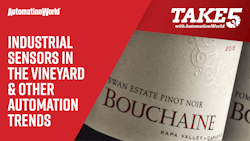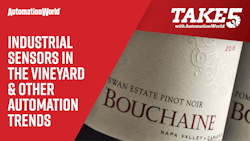Industrial Sensors in the Vineyard & Other Automation Trends

Quick hits:
- Learn how Bouchaine Vineyards is using industrial sensors to track seasonal growing factors and make decisions about their irrigation, leafing, and fruit thinning processes.
- Why the arrival of IO-Link masters is helping boost the use of Ethernet I/O across industry.
- How the COVID-19 pandemic and help from IT is driving increased use of remote access technologies in the manufacturing and processing industries.
- Industrial Sensors Boost Vineyard Data
- Podcast: What is IO-Link?
- Integrators Dish on Industrial Technology Trends
- Visit PMMI's Business Intelligence Library and download their executive summaries of their latest reports for free
Welcome to Take Five with Automation World. I’m David Greenfield, Director of Content at Automation World, and in this episode we’ll be looking at the spread of industrial sensors to applications outside the factory walls and a couple of automation trends that system integrators see as being on the rise.
Let’s start with the sensors. Bouchaine Vineyards is the latest example of a vineyard I’ve run across that’s adopting industrial automation technology. In this case, they’ve implemented Cisco Industrial Asset Vision sensors to track data throughout its 100+ acre growing area in California.
It may seem unusual that a vineyard is using industrial grade sensors in the field, but when you consider that the vineyard is the first step in wine processing, it makes sense to use technologies that can provide the granular insights of an industrial sensor and that can capture data in a way that they can be shared across other production systems.
Cisco Industrial Asset Vision is comprised of eleven new, ruggedized Cisco sensors that come pre-integrated with a Cisco gateway and a new cloud-based data operations and management dashboard designed for monitoring outdoor or industrial indoor environments.
At Bouchaine, the Cisco sensors are used to collect temperature, light, humidity, wind, and water over the course of the growing season. According to Cisco, the sensors are advanced enough to track details such as the amount of light hitting individual grapevines, which can provide the growers with key insights into tannin development in the grapes. It also provides information that enables Bouchaine to refine decisions on their irrigation, leafing and fruit thinning processes.
You can read more about this at the link shown here.
During Inductive Automation’s Ignition Community Conference, they hosted a panel discussion among system integrators to discuss the bigger automation trends they see taking place as they work with end users in the discrete manufacturing and processing industries. Two trends they noted in this discussion were the increased use of Ethernet I/O and remote access technologies.
Cody Warren, who works at system integrator Tamaki Control, said: The rise of Ethernet I/O on the device level has been huge lately. He added that a lot of the work Tamaki has been doing the past couple years has involved upgrading old, out-of-date PLCs and I/O modules. And, he said, much of this work has been made a lot easier with the arrival of IO-Link masters.
If you’re interested in learning more about IO-Link, which has been popular for years now in Europe and is making serious inroads here in the U.S., check out this episode in the “Automation World Gets Your Questions Answered” podcast series.
As for remote access, the main factor boosting this technology recently has been that, like every business today, industrial operations continue to struggle with maintaining effective operations during the ongoing COVID-19 pandemic.
Dustin Wilson, of system integrator Phantom Technical Services, said: “You never know when someone is going to be at work the next day, so being able to call on your integrators remotely and for those integrators to be able to use remote access technology to see and diagnose issues remotely, in real time, instead of having to be on site has been a huge benefit. And Brian McClain, of system integrator Corso Systems, said: Remote monitoring has been a big request this past year not just from plant floor supervisors, but managers who want remote access to production data because they may not be able to go into the facility.
Another factor around the increased use of remote access over the past two years is the effort put in by industrial IT organizations to help facilitate this. McClain said it wasn't too long ago when trying to do something like exposing a visualization dashboard or data for supervisors to see outside of their network was virtually impossible. He said you would talk to IT departments about opening some ports to create the right networking architecture for this and you would just get blank stares from them. But now, more organizations are seeing the benefit of this and creating systems and secure methods that integrators can use to deliver remote access.
So, I hope you enjoyed this Take Five with Automation World. And please keep watching this space for new episodes to help keep you on top of what’s happening in the world of industrial automation.
